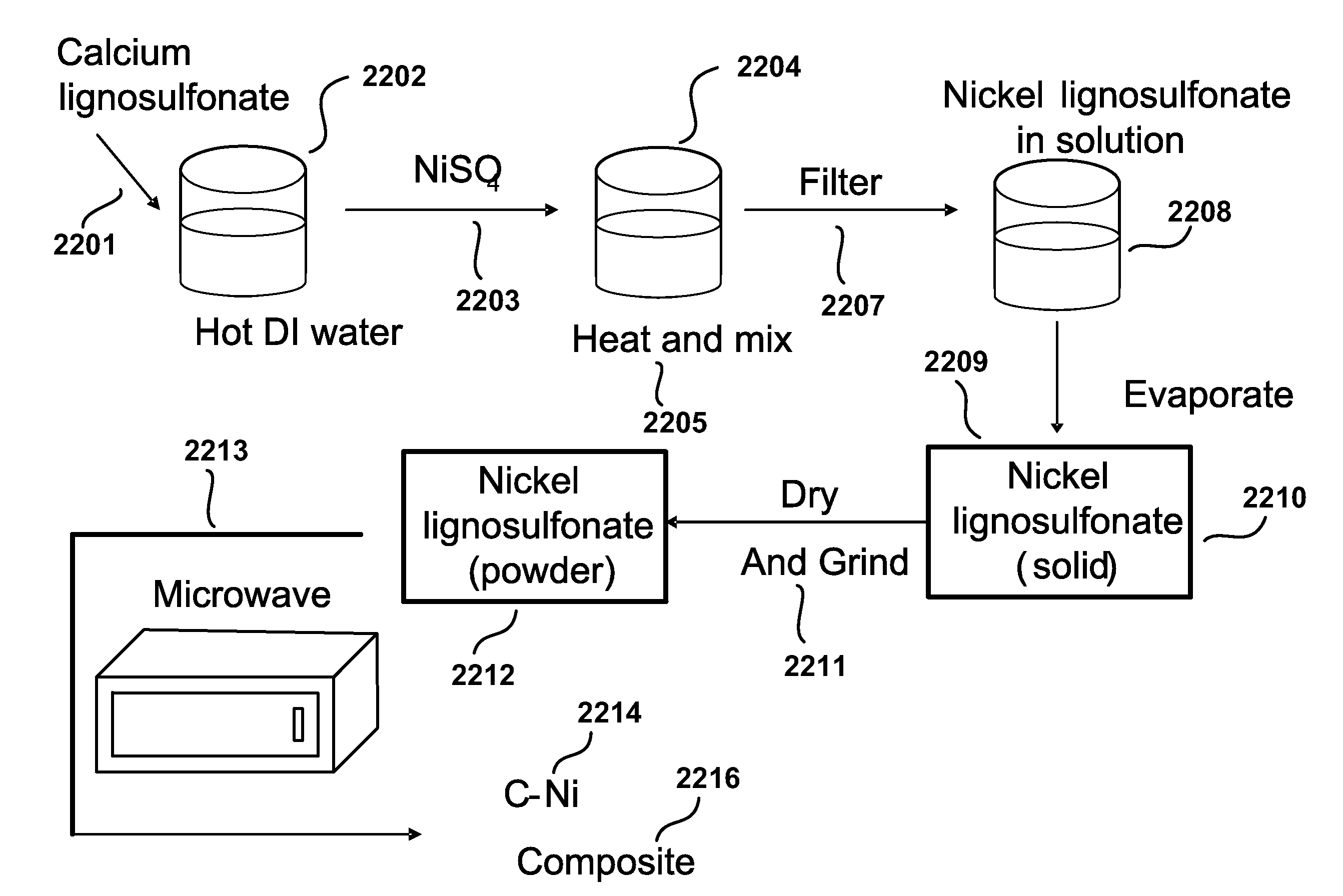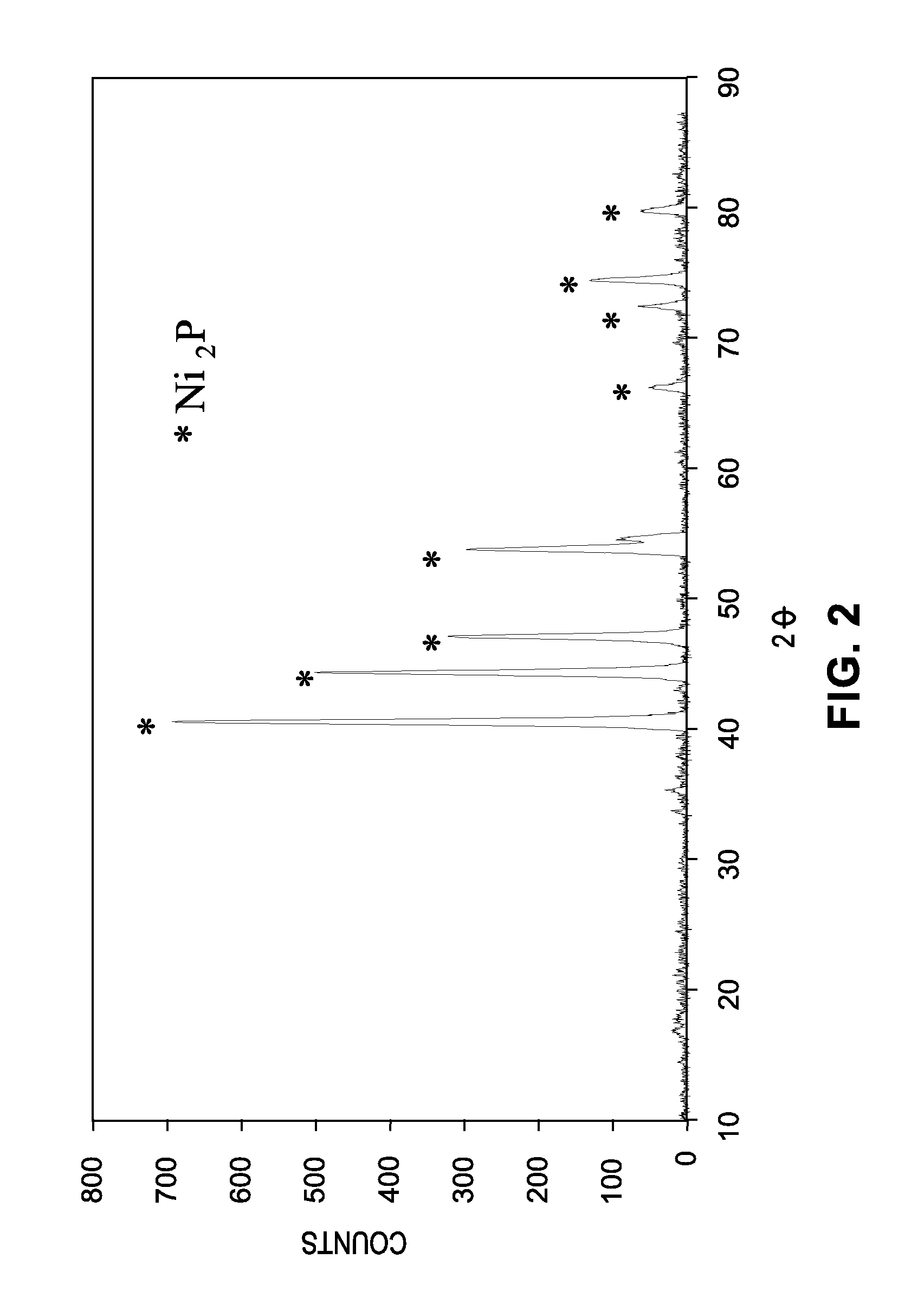Microwave-assisted synthesis of carbon and carbon-metal composites from lignin, tannin and asphalt derivatives and applications of same
a technology of carbon and metal composites, applied in the field of microwave-assisted synthesis of carbon and carbonmetal composites, can solve the problems of deviation from conventional heating sources as well as raw materials
- Summary
- Abstract
- Description
- Claims
- Application Information
AI Technical Summary
Benefits of technology
Problems solved by technology
Method used
Image
Examples
example 1
[0098]This example illustrates a method or process according to one embodiment of the present invention.
[0099]Referring now to FIG. 22, an exemplary process for synthesizing Ni—C nanocomposites is schematically shown according to one embodiment of the present invention. At first, a certain amount of lignosulfonate salt is converted to desired metal lignosulfonate salt prior to carbonization. At step 2201, a 10 g sample of calcium lignosulfonate, which has 5% Ca2+ (0.0125 mol Ca ions), is added to 70 mL of DI water in a container to form a solution. At step 2202, the solution is heated to a temperature range of about 85-90 degrees C. with stirring. At step 2203, a 0.0125 mol sample of nickel sulfate, NiSO4, is then added to the solution to form a reaction mixture. Note that in other embodiments, depending on what metal carbon nanoparticles is desired, other metal salts with metals such as Sb, Li, Rb, Ti, V, Mn, Fe, Co, Cu, Zn, Zr, Mo, Ru, Rh, Pd, Ag, W, Ir, Pt, Au or any mixture of t...
example 2
[0107]This example describes Ni2P nanoparticles that are synthesized according to one embodiment of the present invention utilizing the exemplary process set forth in EXAMPLE 1, or a process similar to it.
[0108]An XRD of the sample prepared shown in FIG. 2 indicates that pure Ni2P is produced. There is an exact match with Ni2P standard file with no other impurities.
[0109]FIG. 3 shows an SEM image of the sample, which shows that the morphology of the sample is in the form of nanospheres, with an average nanosphere size of <100 nm. The fold seen in the middle of the image is likely due to a tape that is used to support the sample.
[0110]There is also evidence of nanosticks but there is strong reason to believe that they are also in fact Ni2P. Liu et. al.4 have observed the formation of such nanosticks projecting from nanospheres in the sample of Ni2P they prepared in an aqueous environment. They propose that aggregated nanoparticles form nanospheres after which the sticks decorate them...
example 3
[0111]This example describes Ni2P nanoparticles that are synthesized according to one embodiment of the present invention utilizing the exemplary process set forth in EXAMPLE 1, or a process similar to it. In this example, however, Ni2P nanoparticles are synthesized on a silica support.
[0112]FIG. 4 shows an XRD of Ni2P prepared in the presence of silica. It can be seen that all the peaks expected from Ni2P are present in the sample. In addition, the characteristic peaks for carbon and silica are also present, respectively. No other peaks are discernable indicating that SiO2 remains unaffected under the reaction conditions.
PUM
| Property | Measurement | Unit |
|---|---|---|
| frequency | aaaaa | aaaaa |
| diameters | aaaaa | aaaaa |
| diameters | aaaaa | aaaaa |
Abstract
Description
Claims
Application Information
 Login to View More
Login to View More - R&D
- Intellectual Property
- Life Sciences
- Materials
- Tech Scout
- Unparalleled Data Quality
- Higher Quality Content
- 60% Fewer Hallucinations
Browse by: Latest US Patents, China's latest patents, Technical Efficacy Thesaurus, Application Domain, Technology Topic, Popular Technical Reports.
© 2025 PatSnap. All rights reserved.Legal|Privacy policy|Modern Slavery Act Transparency Statement|Sitemap|About US| Contact US: help@patsnap.com



